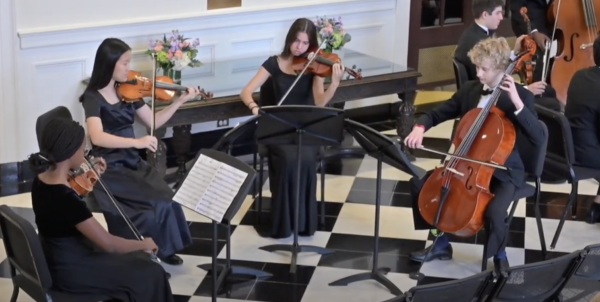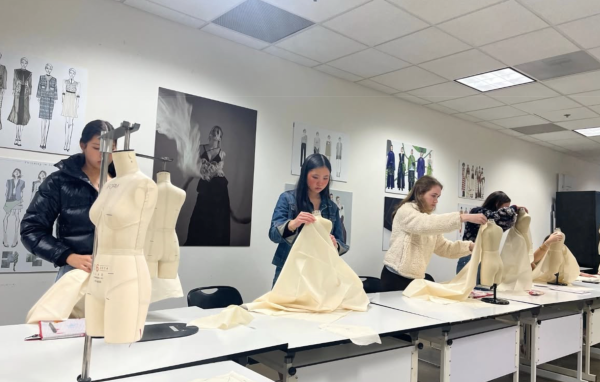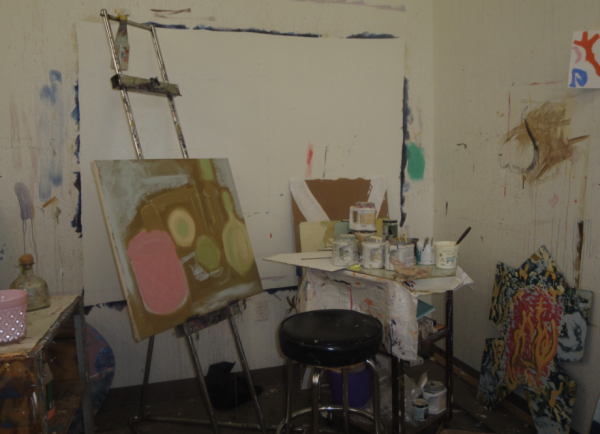Something Rotten! enjoyed by the Westminster community
After months of script editing, auditioning, costume designing, and rehearsing, the Upper School Westminster Players premiered the musical Something Rotten! on April 21 in Kellett Theater. After the dress rehearsal on April 21, the musical had two more performances for the public on April 22 and 23.
The musical, set in 1595, follows the story of the Bottom brothers, who struggle to find fame in an era dominated by Shakespeare’s talent. The play casts a unique and comical light on history.
“It’s a lot like taking a serious idea and a serious time period and flipping it on its head and seeing everything from a new perspective,” said sophomore Caroline Chu. “It’s not about Shakespeare; he’s the evil guy. It’s about Nick and Nigel Bottom, the up-and-coming horrible playwrights!”
Despite its lighthearted subject, preparing the musical was challenging. Actors had to learn the songs and the dances, not just memorize their lines. For example, incorporating music into the characters’ movements was specific to this performance.
“You really have to figure out your voice parts and find it within the music with the live orchestra, which is always slightly different every time, and dance correctly,” said Chu. “There’s a lot more time spent practicing, and it’s a lot more preparation.”
Another challenge involved in the production of the musical was the costume design since the musical is set in 1590s southern London. To ensure that the costumes were true to the time period, costume designers and managers had to do extensive research on the period’s clothing. For example, sophomore Sarah Kim conducted research on ruffs, which are frilly neck collars, and how they are made. After the research was complete, the costume designers had to get a better sense of the action occurring on stage so that the costumes would complement the characters’ actions, such as their tap dancing.
“I went to the auditions to watch some of the early forms of the choreography because part of the audition is a dance audition,” said Kim. “I went to the dance choreography to see what it would be like and get an idea of how fabrics and costumes would move while doing a musical.”
Since some of the costumes were rented and not made by the production crew, some adjustments had to be made. For instance, Kim added small details, like feathers and trinkets, to the costumes to make them more suitable for the musical’s setting. However, costumes could not be permanently altered, so the crew had to resort to creative alterations to ensure a proper fit.
“Since we were renting these costumes from a third party, we were not allowed to permanently alter costumes the way you would normally alter things, which means we couldn’t cut fabric, which means you had to get creative with how you fix stuff,” said Kim. “It is a little frustrating knowing that if you did two snips, everything would fit just perfectly, but instead, you have to go the long and circuitous route.”
Other costumes had to be handmade by the production crew. The process was laborious and required several attempts. After imagining and sketching the outfit, making and tailoring it was even more challenging. Some of the more unusual costumes were particularly labor intensive.
“The biggest challenge was probably the eggs because you’d have to have a giant three-dimensional walking egg,” said Kim. “I went through seven iterations of trying to figure out how that would work.”
Editing the musical’s script was also a challenge. Due to the explicit nature of several lines in the script, theater director Kate Morgens decided to replace many of the default lines with alternate, tamer versions included in the appendix of the playbook. The playwrights include those versions specifically to allow the play to be performed in front of younger audiences.
Other challenges had to do with the timing of the play. Something Rotten! was supposed to premiere sooner, but the onset of the COVID-19 pandemic delayed the production of all musicals due to safety concerns.
“When Covid hit, we had already planned our shows for the next year,” said Morgens. “So we had planned two musicals, and we couldn’t do them because singing requires more air coming out, and it wasn’t safe.”
Once Covid-imposed restrictions were lifted, the cast and crew worked to make the return of musicals special and unique by incorporating new elements into the performance.
“Kari Twyman, the Middle School theater director and dance teacher, choreographed a lot of tap dancing for this play, and we haven’t had tap dancing in about six years,” said Morgens.
Despite the delays, the production of Something Rotten! benefited from a wonderful and unusual opportunity. Through a civic engagement grant, the musical allowed the production members to work with professionals like Judy Klass, a playwright and professor of Jewish studies and theater arts at Vanderbilt. Klass provided meaningful insight into some of the more controversial aspects of the play, such as whether it is acceptable for actors who are not Jewish to play Jewish roles.
“We got this civic engagement grant to talk to Judy Klass about any lines that we were curious about, like New York theater references that are also Jewish references in some ways,” said Morgens. “She helped support us in decisions that we made about casting and about what was appropriate for an educational environment.”
The lighthearted comedy, live music, and stunning choreography in Something Rotten! enchanted the audience and made the play a resounding success.



